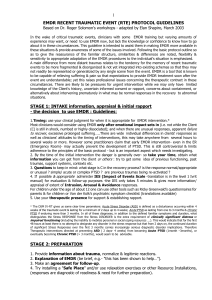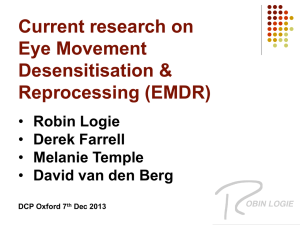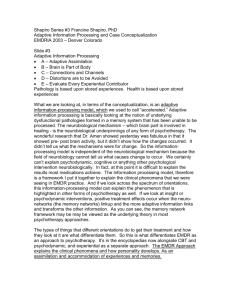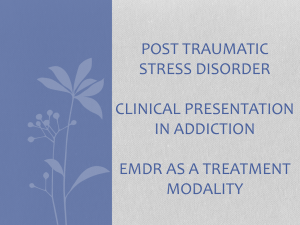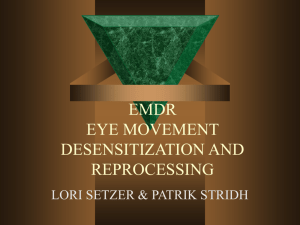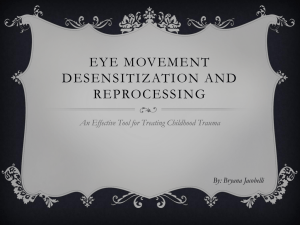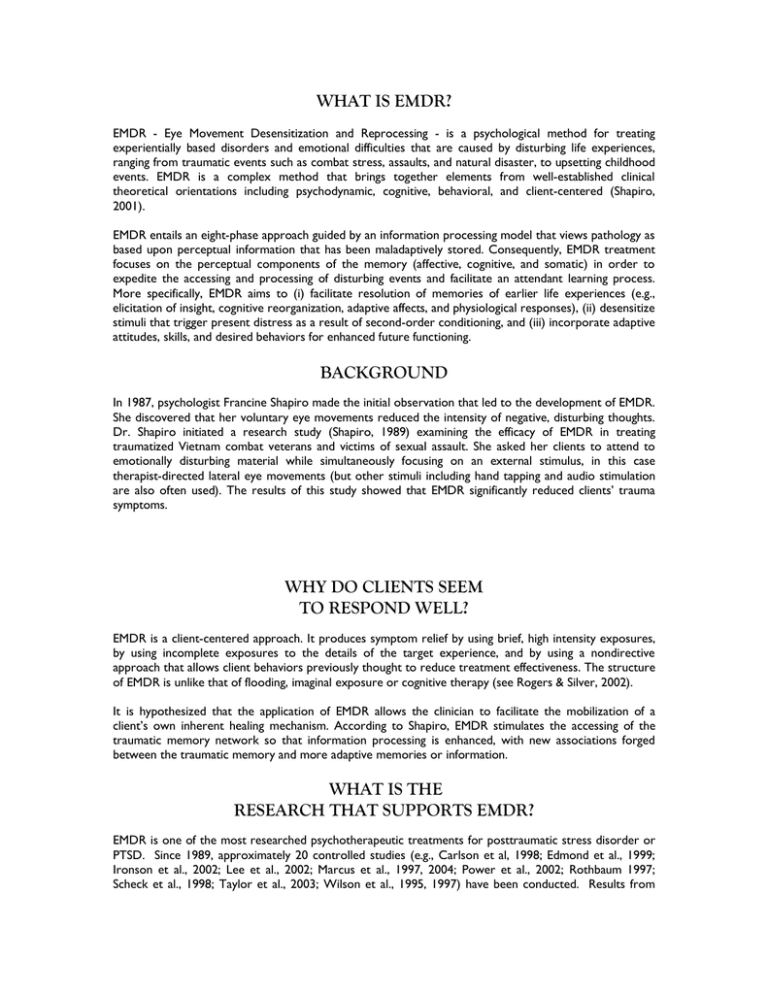
WHAT IS EMDR?
EMDR - Eye Movement Desensitization and Reprocessing - is a psychological method for treating
experientially based disorders and emotional difficulties that are caused by disturbing life experiences,
ranging from traumatic events such as combat stress, assaults, and natural disaster, to upsetting childhood
events. EMDR is a complex method that brings together elements from well-established clinical
theoretical orientations including psychodynamic, cognitive, behavioral, and client-centered (Shapiro,
2001).
EMDR entails an eight-phase approach guided by an information processing model that views pathology as
based upon perceptual information that has been maladaptively stored. Consequently, EMDR treatment
focuses on the perceptual components of the memory (affective, cognitive, and somatic) in order to
expedite the accessing and processing of disturbing events and facilitate an attendant learning process.
More specifically, EMDR aims to (i) facilitate resolution of memories of earlier life experiences (e.g.,
elicitation of insight, cognitive reorganization, adaptive affects, and physiological responses), (ii) desensitize
stimuli that trigger present distress as a result of second-order conditioning, and (iii) incorporate adaptive
attitudes, skills, and desired behaviors for enhanced future functioning.
BACKGROUND
In 1987, psychologist Francine Shapiro made the initial observation that led to the development of EMDR.
She discovered that her voluntary eye movements reduced the intensity of negative, disturbing thoughts.
Dr. Shapiro initiated a research study (Shapiro, 1989) examining the efficacy of EMDR in treating
traumatized Vietnam combat veterans and victims of sexual assault. She asked her clients to attend to
emotionally disturbing material while simultaneously focusing on an external stimulus, in this case
therapist-directed lateral eye movements (but other stimuli including hand tapping and audio stimulation
are also often used). The results of this study showed that EMDR significantly reduced clients’ trauma
symptoms.
WHY DO CLIENTS SEEM
TO RESPOND WELL?
EMDR is a client-centered approach. It produces symptom relief by using brief, high intensity exposures,
by using incomplete exposures to the details of the target experience, and by using a nondirective
approach that allows client behaviors previously thought to reduce treatment effectiveness. The structure
of EMDR is unlike that of flooding, imaginal exposure or cognitive therapy (see Rogers & Silver, 2002).
It is hypothesized that the application of EMDR allows the clinician to facilitate the mobilization of a
client’s own inherent healing mechanism. According to Shapiro, EMDR stimulates the accessing of the
traumatic memory network so that information processing is enhanced, with new associations forged
between the traumatic memory and more adaptive memories or information.
WHAT IS THE
RESEARCH THAT SUPPORTS EMDR?
EMDR is one of the most researched psychotherapeutic treatments for posttraumatic stress disorder or
PTSD. Since 1989, approximately 20 controlled studies (e.g., Carlson et al, 1998; Edmond et al., 1999;
Ironson et al., 2002; Lee et al., 2002; Marcus et al., 1997, 2004; Power et al., 2002; Rothbaum 1997;
Scheck et al., 1998; Taylor et al., 2003; Wilson et al., 1995, 1997) have been conducted. Results from
meta-analyses indicate that EMDR is superior to no-treatment and nonspecific treatment controls and
equivalent in outcome to exposure and other cognitive-behavioral treatment approaches (Davidson &
Parker, 2001; Maxfield & Hyer, 2002; Bradley et al., 2005). Empirical evidence suggests that EMDR is one
of the most efficient treatments for PTSD and that it is more efficient than other trauma treatments (Van
Etten & Taylor, 1998; Power et al., 2002; Jaberghaderi et al., 2004; Rothbaum & Marsteller, 2005).
Studies indicate that EMDR may also be effective in treating various mental disorders, including specific
phobias (De Jongh et al., 1999 & 2002), performance anxiety (Maxfield & Melnyk, 2000), panic disorder
(Goldstein & Feske, 1994), body dysmorphic disorder (Brown, McGoldrick, & Buchanan, 1997), trauma
symptoms in children (Chemtob et al., 2002), complicated mourning (Sprang, 2001), and chronic pain
(Grant & Threlfo, 2002).
EMDR is now accepted by many organizations and agencies for the treatment of trauma. The American
Psychiatric Association Practice Guideline for the Treatment of Patients with Acute Stress Disorder and
Posttraumatic Stress Disorder (2004) have given EMDR the same status as Cognitive Behavior Therapy as
an effective treatment for ameliorating symptoms of both acute and chronic PTSD. The U.S. Department
of Veterans Affairs and Department of Defense has placed EMDR in its highest category of therapies
recommended for treatment of PTSD (Clinical Practice Guidelines, 2004). In addition, the International
Society for Traumatic Stress Studies (ISTSS) designates EMDR as an effective treatment for post traumatic
stress (Chemtob et al., 2000). A taskforce of the Clinical Division of the American Psychological
Association found EMDR as one of only three methods empirically supported for the treatment of any
post-traumatic stress disorder population (1998). EMDR has been determined to be effective for the
treatment of trauma by several international health and governmental agencies including the United
Kingdom Department of Health (2001), the Israeli National Council for Mental Health (2002), the Dutch
National Steering Committee Guidelines Mental Health Care (2003), French National Institute of Health
and Medical Research (2004), (UK) National Institute for Clinical Excellence (2005), and the Medical
Program Committee/Stockholm City Council, Sweden (2003).
WHAT IS EMDR’S
MECHANISM OF ACTION?
While it is not clear how EMDR works, there are ongoing investigations of the possible mechanism by
which EMDR can facilitate a reprocessing of human experience. What is clear to researchers is that
present-day occurrences can restimulate negative thoughts, emotions and physical sensations arising from
earlier experiences that continue to be a source of upset for the client. It appears that EMDR can change
the association of those incidents, greatly decreasing the current distress about both the past and present
events.
Several hypotheses have been proposed to explain how EMDR works to mobilize the rapid processing of
cognitive and emotional material, including (i) linking of memory components, (ii) mindfulness, (iii) free
association, (iv) repeated access and dismissal of traumatic imagery, and (v) eye movements and other
stimuli.
WHAT IS THE ROLE OF
EYE MOVEMENTS IN EMDR?
A commonly proposed hypothesis for the mechanism of action is that it is the dual-attention stimulation
that elicits an orienting response (e.g., MacCulloch & Feldman, 1996). It is possible that the orienting
response induces neurobiological mechanisms that facilitate the activation of episodic memories and their
integration into cortical semantic memory (Stickgold, 2002). A number of studies (e.g., Andrade et al.,
1997; van den Hout et al., 2001) demonstrated that eye movements and other stimuli have an effect on
perceptions of the targeted memory, decreasing image vividness and associated affect. However, several
dismantling studies have failed to support an active role for the eye movements in EMDR. Since most of
these studies have relied on samples that were too small to allow for adequate between-group
discriminations, with very brief treatment trials, and on non-clinical subjects, more research is needed to
clarify the role of the eye movements in EMDR.
WHAT HAPPENS IN EMDR?
During EMDR, the clinician works with the client to identify the specific problem that will be the focus of
treatment. Utilizing a structured protocol, the practitioner guides the client through the description of
the disturbing event or issue, helping the client select important aspects that are upsetting. While the
client is engaged in the eye movements, he or she is experiencing various parts of the initial memory or
other memories. The practitioner pauses with the eye movements at regular intervals to insure that the
client is processing adequately on his or her own. The practitioner facilitates the process, making clinical
decisions about the direction of the intervention. The goal is the client’s rapid processing of information
about the negative experience, bringing it to an “adaptive resolution.” In Shapiro’s words, this means a
reduction in symptoms, a shift from the negative belief to the client’s new positive belief, and the prospect
of functioning more optimally. EMDR treatment may last from 1- 4 sessions for a single trauma to 1 year
or longer for more complex problems.
WHAT IS THE
EMDR INTERNATIONAL ASSOCIATION?
The EMDR International Association (EMDRIA) is a membership organization of mental health
professionals dedicated to the highest standards of excellence and integrity in EMDR. To that end, the
Association distributes brochures, publishes a quarterly newsletter, holds an annual conference, evaluates
training programs, and maintains programs and listings of EMDRIA Certified Therapists and Approved
Consultants, and Providers of Basic EMDR Training.
EMDRIA is the ongoing support system for EMDR trained practitioners and provides the mechanism for
the continued development of EMDR in a professional manner. Through EMDRIA, practitioners have
access to the latest clinical information and research data on EMDR.
FOR INFORMATION ON CERTIFIED EMDR CLINICIANS IN YOUR
AREA, CONTACT:
EMDR International Association
5806 Mesa Drive, Suite 360
Austin, TX 78731-3785
Toll Free: (866) 451-5200
Telephone: (512) 451-5200
Fax: (512) 451-5256
Email: info@emdria.org
Website: www.emdria.org
PLEASE NOTE: The EMDR International Association cannot and does not make referrals to specific
EMDR therapists. The information provided to EMDRIA by those wishing to be Certified is listed without
investigation or verification by EMDRIA. EMDRIA makes no claims or assurances regarding the
qualifications of the practitioners listed as Certified, or the suitability of the services to be rendered by
the practitioner for the needs of the inquiring individual.
REFERENCES
American Psychiatric Association (2004). Practice Guideline for the Treatment of Patients with Acute Stress Disorder and
Posttraumatic Stress Disorder. Arlington, VA: American Psychiatric Association Practice Guidelines
Andrade, J., Kavanagh, D. & Baddeley, A. (1997). Eye-movements and visual imagery: A working memory approach to
the treatment of post-traumatic stress disorders. British Journal of Clinical Psychology, 36, 209-223.
Bleich, A., Kotler, M., Kutz, I., & Shalev, A. (2002) A position paper of the (Israeli) National Council for Mental Health:
Guidelines for the assessment and professional intervention with terror victims in the hospital and in the community.
Jerusalem, Israel.
Bradley, R., Greene, J., Russ, E., Dutra, L., & Westen, D. (2005). A multidimensional meta-analysis of psychotherapy for
PTSD. American Journal of Psychiatry, 162, 214-227.
Brown, K.W., McGoldrick, T., & Buchanan, R. (1997). Body dysmorphic disorder: Seven cases treated with eye
movement desensitization and reprocessing. Behavioral and Cognitive Psychotherapy, 25, 203-207.
Carlson, J.G., Chemtob, C.M., Rusnak, K., Hedlund, N.L. & Muraoka, M.Y. (1998). Eye movement desensitization and
reprocessing for combat-related posttraumatic stress disorder. Journal of Traumatic Stress, 11, 3-24.
Chambless, D.L, Baker, M., Baucom, D., Beutler, L., Calhoun, K., Crits-Christoph, P., Daiuto, A., DeRubeis, R.,
Detweiler, J., Haaga, D., Bennett Johnson, S., McCurry, S., Mueser, K., Pope, K., Sanderson, W., Shoham, V.,
Stickle, T., Williams, D. & Woody, S. (1998). Update on empirically validated therapies, II. The Clinical
Psychologist, 51, 3-16
Chemtob, C.M., Nakashima, J. & Carlson, J.G. (2002). Brief treatment for elementary school children with disasterrelated posttraumatic stress disorder: A field study. Journal of Clinical Psychology, 58, 99-112.
Chemtob, C.M., Tolin, D.F., van der Kolk, B.A., & Pitman, R.K. (2000). Eye movement desensitization and
reprocessing. In: E.A. Foa, T.M. Keane & M.J. Friedman [Eds.], Effective treatments for PTSD: Practice Guidelines
from the International Society for Traumatic Stress Studies (pp.139-155 & 333-335). New York: Guilford Press.
Davidson, P.R. & Parker, K.C.H. (2001). Eye movement desensitization and reprocessing (EMDR): A meta-analysis.
Journal of Consulting and Clinical Psychology, 69, 305-316.
De Jongh, A., Ten Broeke, E. & Renssen, M. R. (1999) Treatment of specific phobias with Eye Movement
Desensitization and Reprocessing (EMDR): Protocol, empirical status and conceptual issues. Journal of Anxiety
Disorders, 13, 69-85.
De Jongh, A., Van den Oord, H.J.M. & Ten Broeke, E. (2002). Efficacy of eye movement desensitization and
reprocessing (EMDR) in the treatment of specific phobias: Four single-case studies on dental phobia. Journal of
Clinical Psychology, 58, 1489-1503.
Department of Veterans Affairs & Department of Defense (2004) VA/DoD Clinical Practice Guideline for the Management
of Post-Traumatic Stress. Washington, DC.
Dutch National Steering Committee Guidelines Mental Health Care (2003). Multidisciplinary Guideline Anxiety
Disorders. Quality Institute Heath Care CBO/Trimbos Institute. Utrecht, Netherlands.
Edmond, T., Rubin, A. & Wambach, K.G. (1999). The effectiveness of EMDR with adult female survivors of childhood
sexual abuse. Social Work Research, 23, 103-116.
Edmond, T., Sloan, L., & McCarty, D. (2004). Sexual abuse survivors’ perceptions of the effectiveness of EMDR and
eclectic therapy: A mixed-methods study. Research on Social Work Practice, 14, 259-272.
Foa, E.B., Keane, T.M., & Friedman, M.J. (2000). Effective treatments for PTSD: Practice Guidelines of the International
Society for Traumatic Stress Studies New York: Guilford Press.
Goldstein, A., & Feske, U. (1994). Eye movement desensitization and reprocessing for panic disorder: A case series.
Journal of Anxiety Disorder, 8, 351-362.
Grant, M. & Threlfo, C. (2002). EMDR in the treatment of chronic pain. Journal of Clinical Psychology, 58, 1505-1520.
INSERM (2004). Psychotherapy: An evaluation of three approaches. French National Institute of Health and Medical
Research, Paris, France.
Ironson, G., Freund, B., Strauss, J.L. & Williams, J. (2002). Comparison of two treatments for traumatic stress: A
community-based study of EMDR and prolonged exposure. Journal of Clinical Psychology, 58, 113-128.
Jaberghaderi, N., Greenwald, R., Rubin, A., Dolatabadim S., & Zand, S.O. (2004). A comparison of CBT and EMDR
for sexually abused Iranian girls. Clinical Psychology and Psychotherapy, 11, 358-368.
Lee, C., Gavriel, H., Drummond, P, Richards, J. & Greenwald, R. (2002). Treatment of PTSD: Stress inoculation
training with prolonged exposure compared to EMDR. Clinical Psychology, 58, 1071-1089.
MacCulloch, M.J. & Feldman, P. (1996). Eye movement desensitization treatment utilizes the positive visceral element of
the investigatory reflex to inhibit the memories of post-traumatic stress disorder: British Journal of Psychiatry,
169, 571-579.
Marcus, S.V., Marquis, P. & Sakai (1997). Controlled study of treatment of PTSD using EMDR in an HMO setting.
Psychotherapy, 34, 307-315.
Marcus, S., Marquis, P. & Sakai, C. (2004). Three- and 6-month follow-up of EMDR treatment of PTSD in an HMO
setting. International Journal of Stress Management, 11, 195-208.
Maxfield, L. & Hyer, L. (2002). The relationship between efficacy and methodology in studies investigating EMDR
treatment of PTSD. Journal of Clinical Psychology, 58, 23-41.
Maxfield, L. & Melnyk, W.T. (2000). Single session treatment of test anxiety with eye movement desensitization and
reprocessing (EMDR). International Journal of Stress Management, 7, 87-101.
National Institute for Clinical Excellence (2005). Post traumatic stress disorder (PTSD): The management of adults and
children in primary and secondary care. London: NICE Guidelines.
Power, K., McGoldrick, T., Brown, K., Buchanan R., Sharp D., Swanson, V. & Karatzias, A. (2002). A Controlled
Comparison of Eye Movement Desensitization and Reprocessing versus Exposure plus Cognitive
Restructuring versus Waiting List in the Treatment of Post-traumatic Stress Disorder. Clinical Psychology and
Psychotherapy, 9, 299-318.
Rogers, S., Silver, S.M. (2002). Is EMDR exposure therapy? A review of trauma protocols. Journal of Clinical Psychology,
58, 43-59.
Rothbaum, B.O. (1997). A controlled study of eye movement desensitization and reprocessing for posttraumatic stress
disordered sexual assault victims. Bulletin of the Menninger Clinic, 61, 317-334.
Rothbaum, B.O., Astin, M.C., & Marsteller, F. (2005). Prolonged exposure versus eye movement desensitization
(EMDR) for PTSD rape victims. Journal of Traumatic Stress, 18, 607-616.
Scheck, M.M., Schaeffer, J.A. & Gillette, C.S. (1998). Brief psychological intervention with traumatized young women:
The efficacy of eye movement desensitization and reprocessing. Journal of Traumatic Stress, 11, 25-44.
Shapiro, F. (1989). Efficacy of the eye movement desensitization procedure in the treatment of traumatic memories.
Journal of Traumatic Stress, 2, 199-223.
Shapiro, F. (2001). Eye movement desensitization and reprocessing: Basic principles, protocols and procedures (2nd ed.). New
York: Guilford Press.
Sjöblom, P.O., Andréewitch, S . Bejerot, S., Mörtberg, E. , Brinck, U., Ruck, C., & Körlin, D. (2003). Regional
treatment recommendation for anxiety disorders. Stockholm: Medical Program Committee/Stockholm City
Council, Sweden.
Soberman, G. B., Greenwald, R., & Rule, D. L. (2002). A controlled study of eye movement desensitization and
reprocessing (EMDR) for boys with conduct problems. Journal of Aggression, Maltreatment, and Trauma, 6, 217236.
Sprang, G. (2001). The use of eye movement desensitization and reprocessing (EMDR) in the treatment of traumatic
stress and complicated mourning: Psychological and behavioral outcomes. Research and Social Work Practice, 11,
300-320.
Stickgold, R. (2002). EMDR: A putative neurobiological mechanism of action. Journal of Clinical Psychology, 58, 61-75.
Taylor, S., Thordarson, D. S., Maxfield, L., Fedoroff, I. C., Lovell, K., & Ogrodniczuk, J. (2003). Comparative efficacy,
speed, and adverse effects of three PTSD treatments: Exposure therapy, EMDR, and relaxation training.
Journal of Consulting and Clinical Psychology, 71, 330-338.
United Kingdom Department of Health. (2001). Treatment choice in psychological therapies and counseling evidence
based clinical practice guideline. London, England.
Van den Hout, M., Muris, P., Salemink, E. & Kindt, M. (2001). Autobiographical memories become less vivid and
emotional after eye movements. British Journal of Clinical Psychology, 40, 121-130.
Van Etten M.L. & Taylor, S. (1998). Comparative efficacy of treatments for posttraumatic stress disorder: A metaanalysis. Clinical Psychology and Psychotherapy, 5, 126-144.
Vaughan, K., Armstrong, M.F., Gold, R., O'Connor, N., Jenneke, W., & Tarrier, N. (1994). A trial of eye movement
desensitization compared to image habituation training and applied muscle relaxation in post-traumatic stress
disorder. Journal of Behavior Therapy & Experimental Psychiatry, 25, 283-291.
Wilson, S.A., Becker, R.H. & Tinker, R.H. (1995). Eye movement desensitization and reprocessing (EMDR) treatment
for psychologically traumatized individuals. Journal of Consulting and Clinical Psychology, 63, 928-937.
Wilson, S.A., Becker, L.A. & Tinker, R.H. (1997). Fifteen-month follow-up of eye movement desensitization and
reprocessing (EMDR) treatment for PTSD and psychological trauma. Journal of Consulting and Clinical Psychology,
65, 1047-1056.
(c) 2006 All Rights Reserved

